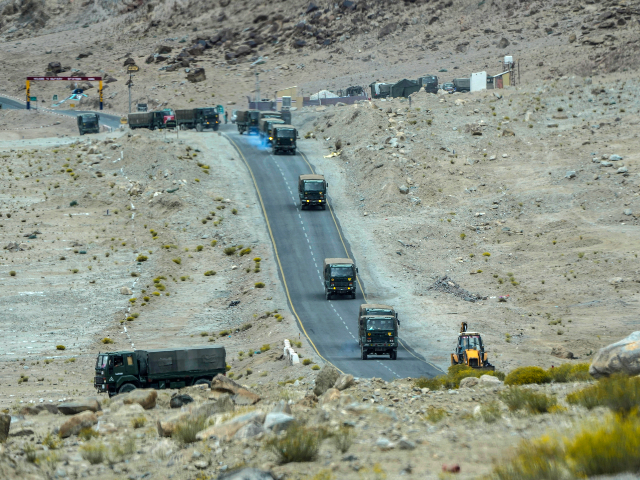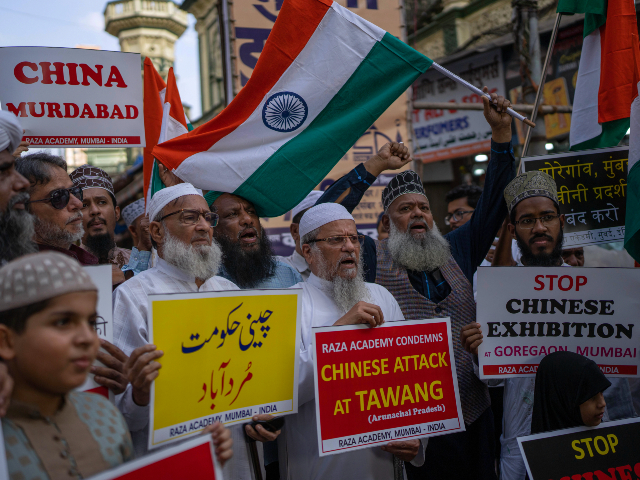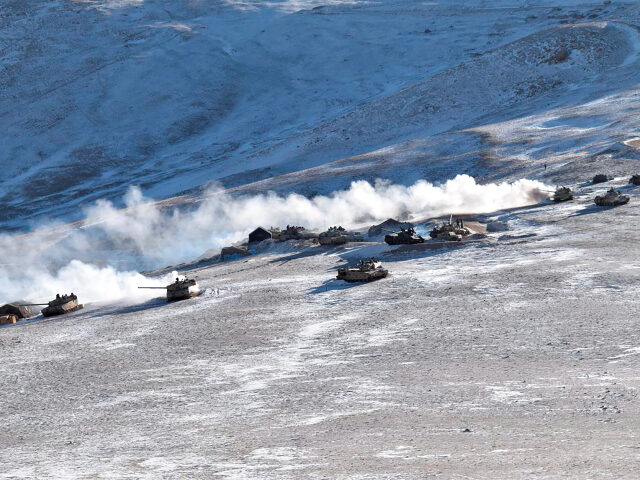Multiple leaks of police research papers and opinions from a recent law enforcement conference in India revealed that regional officials in Ladakh, one of several border regions with China, expect “frequent” violent exchanges with that country as a result of Beijing’s growing belligerence there, Reuters reported on Friday.
The Indian newspaper the Hindu and the Press Trust of India (PTI) published other leaks apparently from the All India Conference of Directors General and Inspectors General of Police, held last week, indicating that Indian officers stationed near China are concerned that New Delhi has not done enough to engage the locals – leaving a void for China to fill – and that economic incentives must accompany traditional border protection initiatives. The authors of the research and presentations reported on Thursday and Friday of this week delivered their results at the conference on January 21 and 22; the conclusions are of particular note because Hindu nationalist Prime Minister Narendra Modi attended the summit and is expected to act on them.
The relationship between China and India, particularly regarding their Himalayan border, has been in free fall since June 2020, when a group of People’s Liberation Army (PLA) soldiers crossed into India and began erecting tents on Indian sovereign territory. When Indian border soldiers confronted them, the PLA soldiers attacked. The brawl, now known by the name of the Galwan Valley where it occurred, featured brutal fighting with rocks, sticks wrapped in barbed wire, and other rudimentary weapons. China has claimed only four deaths in that exchange since it occurred, but Indian officials insist China’s death toll was closer to 40 – about double the number of Indian soldiers killed.

Indian army vehicles move in a convoy in the cold desert region of Ladakh, India, Tuesday, Sept. 20, 2022. Nestled between India, Pakistan and China, Ladakh has not just faced territorial disputes but also stark climate change. (AP Photo/Mukhtar Khan)
Subsequent clashes have continued throughout the past three years. Most recently, in December, the Indian government accused Chinese soldiers of invading Arunachal Pradesh, an Indian region bordering occupied Tibet, prompting another crude weapons melee.
“On 9 December 2022, PLA troops crossed the LAC [Line of Actual Control, the formal name of the China-India border] in the Tawang sector, which was contested by own troops in a firm and resolute manner,” the Indian Army said in a statement at the time.
The excerpt of an Indian “confidential research paper” Reuters claimed to obtain access to on Friday warned government officials to expect more such exchanges.
“Given the domestic compulsions … in China and their economic interests in the region, the PLA would continue to build up its military infrastructure and skirmishes would also get frequent which may or may not follow a pattern,” Reuters quoted the report as stating. “If we analyse the pattern of skirmishes and tensions, the intensity has increased since 2013-2014 with an interval of every 2-3 years.”
The Hindu published excerpts it claims also came from a research paper presented at the conference that warned India was at a disadvantage to China on the border because the civilians who lived there did not feel especially connected to the Indian government.
“This sense of alienation and insecurity has led to insurgency for integration and fight for unification of ethnic groups/identity on both sides of the border,” the report read. “This has been further exploited by China to cause insurgency and instability in the North-east [NE] India. Over the years, it has been observed that most of the arms and ammunition used by NE insurgents are sourced from China which had been transported through Myanmar route.”
The paper warned that the “historical link” between local populations and the Chinese government was a potential threat to China.
“If we have to take on China more successfully, then we have to engage the people in North East and sort out the issues,” the report warned.
Similarly, the PTI reported that attendees at the conference urged the government to build up economic incentives for locals to discourage alliances with China. The paper PTI reported on suggested expanding tourism in the region.
“The paper noted that for inviting a large number of tourists, nomadic festivals at all Indian levels should be celebrated at Ladakh’s Demchok, Koyul, Dungti, and Kakjung villages,” PTI reported, “which are located on the banks of the Indus river and very close to the Line of Actual Control (LAC). According to the paper, the Chota Kailash at Demchok can be opened to tourists to pay obeisance and prayers for the mount Kailash and promote religious tourism for the devout Hindus who cannot go to Mansarovar yatras.”

Indians hold placards as they shout slogans during a protest against China in Mumbai, India, Tuesday, Dec. 13, 2022. Soldiers from India and China clashed last week along their disputed border, India’s defense minister said Tuesday, in the latest violence along the contested frontier since June 2020, when troops from both countries engaged in a deadly brawl. (AP Photo/Rafiq Maqbool)
It is not clear from the three reports if all three news outlets observed the same report; it is possible that different reports on the border leaked to different outlets. The Indian government has yet to comment at press time on the reports. In observance of the Lunar New Year, the Chinese Foreign Ministry has not held its regular press briefings this week and thus has not commented on the reports.
The border was a topic of discussion on Thursday, however, in a conversation between Chinese Vice Foreign Minister Sun Weidong – the outgoing Chinese ambassador to India – and Indian Ambassador to China Pradeep Kumar Rawat.
“The China-India border situation is generally stable at the moment, and is switching from emergency response to normalized management and control,” Sun claimed in a statement following the talks, urging India to “properly manage differences” with China.
Rawat, in turn, reportedly noted the “turbulent … international situation” and urged China to “view bilateral relations in the long run.”
Diplomacy aside, Indian External Affairs Minister S. Jaishankar revealed in remarks to the Indian Parliament that his government had built up an unprecedented military presence on the Chinese border since the Galwan Valley showdown as of December.
“Today we have a deployment of the Indian Army on the China border that we have never had. It is done in order to counter Chinese deployment which has been scaled up massively since 2020,” Jaishankar said. “If we were in denial then how is the Army out there?”
Jaishankar made the remarks in a tumultuous Parliament session in which the opposition Congress party accused Modi of neglecting the border, allowing the brawl that month.
“If we were indifferent to China then who sent the Indian Army to defend our posts … Why are we pressuring China for de-escalation and disengagement? Why are we saying publicly that our relations are not normal?” Jaishankar asked.

COMMENTS
Please let us know if you're having issues with commenting.